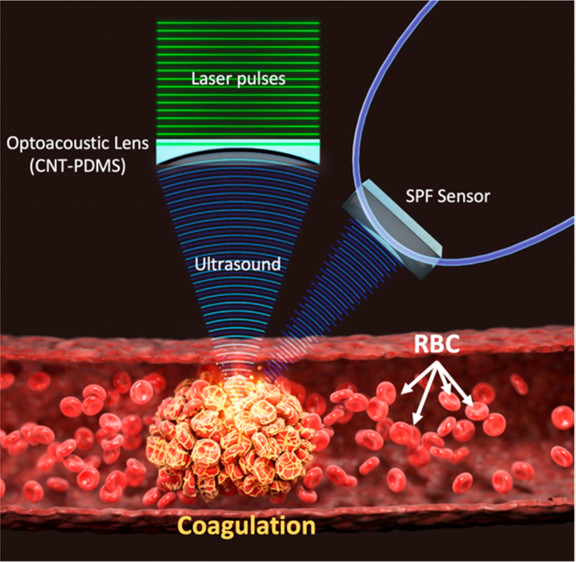Micro-ultrasonic Assessment of Early Stage Clot Formation and Whole Blood Coagulation Using an All-Optical Ultrasound Transducer and Adaptive Signal Processing Algorithm
- Journal
- ACS Sensors
- Vol. (No.), pp.
- 7 (10), 2940-2950 (Oct 2022)
- Year
- 2022
Abnormal formation of solid thrombus inside a blood vessel can cause thrombotic morbidity and mortality. This necessitates early stage diagnosis, which requires quantitative assessment with a small volume, for effective therapy with low risk to unwanted development of various diseases. We propose a micro-ultrasonic diagnosis using an all-optical ultrasound-based spectral sensing (AOUSS) technique for sensitive and quantitative characterization of early stage and whole blood coagulation. The AOUSS technique detects and analyzes minute viscoelastic variations of blood at a micro-ultrasonic spot (<100 μm) defined by laser-generated focused ultrasound (LGFU). This utilizes (1) a uniquely designed optical transducer configuration for frequency-spectral matching and wideband operation (6 dB widths: 7–32 MHz and d.c. ∼ 46 MHz, respectively) and (2) an empirical mode decomposition (EMD)-based signal process particularly adapted to nonstationary LGFU signals backscattered from the spot. An EMD-derived spectral analysis enables one to assess viscoelastic variations during the initiation of fibrin formation, which occurs at a very early stage of blood coagulation (1 min) with high sensitivity (frequency transition per storage modulus increment = 8.81 MHz/MPa). Our results exhibit strong agreement with those obtained by conventional rheometry (Pearson’s R > 0.95), which are also confirmed by optical microscopy. The micro-ultrasonic and high-sensitivity detection of AOUSS poses a potential clinical significance, serving as a screening modality to diagnose early stage clot formation (e.g., as an indicator for hypercoagulation of blood) and stages of blood-to-clot transition to check a potential risk for development into thrombotic diseases.


